The average annual Veterans’ Disability Benefit currently stands at $25,046, a figure that underscores the ongoing conversation about how the U.S. government supports veterans who have suffered service-related injuries. This statistic, while significant, raises questions about the adequacy of these benefits and how they compare to the actual needs of the veteran population. With around 4.7 million veterans receiving disability compensation, this financial support plays a crucial role in their daily lives, impacting everything from housing stability to access to healthcare services. As veterans continue to advocate for better benefits, understanding the landscape of disability compensation becomes increasingly essential.
Understanding Veterans’ Disability Benefits
Veterans’ Disability Benefits are designed to compensate veterans for disabilities resulting from injuries or diseases incurred during military service. The amount a veteran receives can depend on several factors, including the severity of the disability, the number of dependents, and the veteran’s overall service record.
Eligibility Criteria
- Service Connection: The disability must be linked to military service.
- Disability Rating: The Department of Veterans Affairs (VA) assigns a rating from 0% to 100%, which determines the benefit amount.
- Length of Service: Time served in the military can affect eligibility, particularly for certain programs.
How the Average Benefit is Calculated
The average benefit of $25,046 is derived from a combination of factors, including the number of claims filed, the types of disabilities reported, and adjustments based on cost-of-living increases. Each veteran’s situation is unique, which means that benefits can vary widely. For instance, veterans with more severe disabilities may receive significantly higher compensation, while those with lower ratings might receive the minimum amount.
Comparative Analysis
A comparison of benefits across different states reveals substantial disparities. For instance, veterans in states with higher costs of living may find the average benefit insufficient to meet their needs. The following table outlines benefits in various states:
| State | Average Benefit |
|---|---|
| California | $28,500 |
| Texas | $23,400 |
| Florida | $24,800 |
| New York | $27,000 |
Challenges Faced by Veterans
Despite the provision of these benefits, many veterans report facing challenges in accessing the care and support they need. Issues such as lengthy application processes, bureaucratic hurdles, and insufficient funding for mental health services contribute to a climate of frustration. According to a report from the Department of Veterans Affairs, nearly 30% of veterans expressed dissatisfaction with their benefits experience.
Advocacy and Future Directions
Veteran advocacy groups are actively pushing for reforms aimed at improving the benefits system. Efforts include lobbying for increased funding, streamlined application processes, and enhanced mental health services. As more veterans engage in these discussions, the hope is that legislative changes will better reflect the realities faced by those who have served.
Resources for Veterans
Veterans seeking assistance with their disability benefits can access a variety of resources:
- U.S. Department of Veterans Affairs – Disability Compensation
- Veterans Life – Support and Resources
- Military.com – Veterans Disability Benefits
As the conversation around veterans’ benefits continues to evolve, understanding the nuances of disability compensation remains vital. The challenges and successes of veterans in navigating this system not only shape their lives but also reflect on the broader society’s commitment to those who have served.
Frequently Asked Questions
What is the average Veterans’ Disability Benefit amount?
The average Veterans’ Disability Benefit amount is approximately $25,046 per year. This figure represents the typical compensation that veterans receive for service-related disabilities.
How is the Veterans’ Disability Benefit calculated?
The Veterans’ Disability Benefit is calculated based on several factors, including the severity of the veteran’s disability, years of service, and any additional dependents. The Department of Veterans Affairs (VA) uses a rating system to determine these benefits.
Can I appeal my Veterans’ Disability Benefit decision?
Yes, veterans who disagree with their Veterans’ Disability Benefit rating can appeal the decision. The VA provides a clear process for appeals, allowing veterans to present additional evidence or request a review of their case.
Are there additional benefits available for veterans?
Yes, in addition to the Veterans’ Disability Benefit, veterans may qualify for other forms of assistance, such as education benefits, housing assistance, and health care services. Each program has its own eligibility requirements.
What should I do if I believe I am not receiving the average Veterans’ Disability Benefit?
If you believe you are not receiving the average Veterans’ Disability Benefit, you should contact the VA for a review of your case. It may also be helpful to seek assistance from a veterans’ service organization for guidance on how to proceed.








